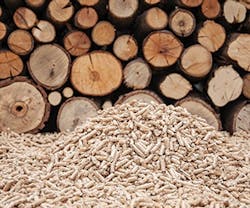Wood Alternatives to Fossil Fuels
Could scraps from sawmills and furniture manufacturers become an affordable, eco-friendly heating option for your facility?
Wood chips and pellets – a compressed form of wood-based waste that resembles rabbit feed – are growing in popularity as a green replacement for conventional heating fuels. A study by Transparency Market Research predicted the global market for pellets alone would more than triple by 2023, reaching an estimated value of $20 billion from its 2014 benchmark of $6.2 billion.
Forest-based fuels could boost your green bona fides while saving dollars. Implement a cost-effective wood fuel program with these tips.
1) Understand Equipment Requirements
Not surprisingly, you can’t just throw a handful of chips or pellets into your existing oil or gas boiler and call it a day. Depending on your heating system, you may be able to co-fire wood or other types of biomass with coal.
Otherwise, you may have to retrofit a pellet boiler that burns the wood directly or a wood gasification system that subjects the pellets or chips to high temperatures and a low oxygen level until they release combustible gases. The heat and gas released from these configurations can then heat the water in an existing hot water heating system.
A handful of Massachusetts schools switched to pellet boilers during a state upgrade program funded by the Massachusetts Department of Energy. The Southern Berkshire School District replaced oil burners at Mount Everett Regional High School and Undermountain Elementary School with a renewable thermal-biomass system that burns pellets. This saves an estimated $46,000 in energy per year – nearly a quarter of the $200,000 they were spending annually on 55,000 gallons of heating oil.
2) Plan for Storage Space
Whether you opt for pellets or chips, the wood will takeup considerably more space than heating oil, so make sure you have enough storage space.
You may also need extra room for additional equipment –a wood heating system isn’t just a one-for-one boiler replacement. It requires a hopper to hold chips or pellets until they’re needed for burning, at which point it will drop them into the combustion or gasification chamber through an auger. It may be easiest to follow the lead of the North Country School in Lake Placid, NY, which pipes heat from a centrally located utility building that houses its 1.4 MMBTU/h wood boiler.
This boarding school also solved the fuel storage problem by sourcing wood chips from the sustainably managed forest woodlot near campus. When trees are removed periodically to improve timber health, they now find a new life as heat for the school.
3) Examine Local Resources
If harvesting your own fuel isn’t an option, examine other potential resources nearby. Wood processing or timber harvesting companies are good places to start.
The Blue Mountain District Hospital in John Day, OR, obtains its wood pellets from the Malheur Lumber Company, a local sawmill that performs sustainable forest thinning like the North Country School. The hospital’s pellet boiler replaced a 1950s-era crude oil boiler and now complements two heating oil boilers, fulfilling federal and state requirements that mandate two types of heating available at any time. The upgrade saved the 50,000-square-foot hospital roughly $100,000 per year in heating costs.
